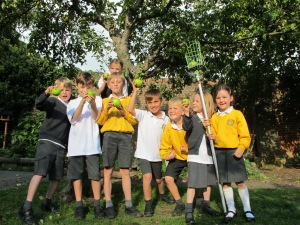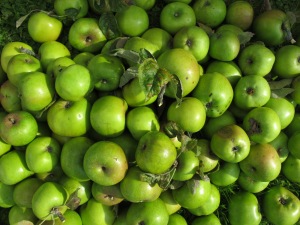 This year has been a bumper year for apples; the Bramley tree in the garden next door is supplying us with a weekly supply from its overhanging branches, and the market stalls are full of home-grown apple varieties.
This year has been a bumper year for apples; the Bramley tree in the garden next door is supplying us with a weekly supply from its overhanging branches, and the market stalls are full of home-grown apple varieties.
One school in St Albans town centre has produced so many apples that it is now supplying them to families at the school, and to The Pudding Stop, who are turning them into delicious puddings that we can all buy.
Aboyne Lodge Primary School, tucked away in the centre of St Albans, used to be on the site of an orchard and has a number of mature trees in the grounds. The school sometimes uses them for cooking, but there are still plenty left. Parent Luke Greysmith spotted a sign in The Pudding Stop, Verulam Road, asking for windfalls, and spoke to the owner Johnny Shepherd to see if he would like some of the school apples.
In return, Johnny supplies puds to the school for them to sell or raffle for fundraising. He also uses the apples to make the puds he sells in the shop and at the van by St Albans station. If you buy apple and custard doughnuts, apple and bilberry pie, apple and blackberry crumble, apple syllabub or apple and blackberry eve’s pudding, there is a good chance the apples have come from Aboyne Lodge. (The Pudding Stop makes very good custard to go with the puds too!)
The Pudding Stop have produced recipe cards this year featuring apple recipes which you can buy in the shop for 50p each; proceeds go back to the school. You can sometimes also buy spare apples to take home; it depends on how many are needed for doughnuts! Recent proceeds have helped the school pay to prune the trees correctly and to help pay for food-related activities. The Urban Orchard Project visited the school recently to advise on apple tree care and hosted an assembly, where they held a competition to see who could get the longest peel using their apple peeling machine.
It’s fantastic to hear about a school making the most of their produce. I am sure there are more schools and local businesses who could pair up in this way too. Johnny (who was on the first series of GBBO) has kindly given us a recipe for our readers; ideal if you also have a glut of apples.
Apple & Bilberry Pie from The Pudding Stop
Bilberries are native to the British Isles and are closely related to the North American blueberry. If you lived north of the Midlands a century ago you would almost certainly be eating bilberry pie every Sunday. Bilberries are tricky little berries to cultivate and so are usually found in the wild – enthusiastic foragers seek them in August and September. If you cannot find a bilberry bush, some supermarkets stock them in jars with syrup, or you can use blueberries.
Serves 8–10
For the shortcrust pastry
225g plain flour, sifted
120g cold, unsalted butter (or 60g butter and 60g lard)
50g icing sugar
A pinch of sea salt flakes
2 tablespoons cold water
1 egg, beaten to glaze the pie
Caster sugar, for sprinkling
For the pie filling
500 g Aboyne Lodge apples, peeled, cored and sliced
250g bilberries
100g caster sugar
1. Put the flour in a large bowl. Cut the butter (and lard if using) into little cubes and rub into the flour with your fingertips. Stir in the icing sugar and salt.
2. Make a well in the centre of the mixture and pour in the cold water. Bring the pastry together into a dough using your hands. Tip the dough out onto a lightly floured surface and knead a couple of times to get it into a nice ball.
3. Wrap the pastry in cling film and chill for at least 30 minutes.
4. Preheat the oven to 200°C/400°F/gas mark 6.
5. Put the apples in a round 28 x 5cm pie dish and stir in the bilberries. Arrange the fruit so that it mounds up in the middle. Sprinkle the fruit with the caster sugar. Pour cold water into the dish until it reaches halfway up the dish.
6. Roll out the pastry on a floured work surface to 3mm thick and cut a strip long enough to lie around the edge of the pie dish. Brush the rim of the pie dish with water, stick the strip of pastry to it, then brush with some of the beaten egg. Use the rest of the pastry to cover the pie dish and pinch to seal and crimp the edges to the rim using your thumb and first finger. Run a knife around the pie dish to neaten up any surplus pastry.
6. Make a hole in the middle of the pastry lid to allow steam to escape and insert a pie funnel if you have one to hand. Brush all over the pastry with more beaten egg. Sprinkle liberally with caster sugar and bake for 15 minutes. Lower the oven temperature to 180°C/350°F/gas mark 4 and bake for a further 45 minutes. Check the apples are cooked by inserting a sharp knife – if there is no resistance the pie is ready.
7. Remove from the oven and leave to rest before serving with custard.
Tip: Using a pie funnel will release any excess steam and will support the structure of the pie.


I have attached a link to the school’s blog, could I use the pic too?
Hi the photo came from the school via parent Luke Greysmith so as long as ok with them, yes.
Aboyne Lodge School was built in the grounds of a large house known as Aboyne Lodge, which formerly stood at the north end of St Peter’s Street, south of Adeleide Street. Hertfordshire County Council bought the house and its grounds after the Second World War. The house was demolished and the frontage on St Peter’s Street became commercial buildings (until recently McDonalds, and now the Metro Bank and Premier Inn).
The school was built in the grounds of the house, which included an orchard. It was one of the earliest of the wave of schools needed after the war, constructed using an innovative system such that it is now a Grade II listed building, and it was highlighed as the “school in the orchard” at the Festival of Britain. There is a photo of the school grounds from the 1960 – still very arboreal and green – here: https://books.google.co.uk/books?id=4RwIw9XMszQC&pg=PA51
And more detail on the history here: http://www.stalbanshistory.org/page_id__397.aspx
Thank you Andrew – that is very interesting. It all sounds much lovelier then.
You are very welcome. More on that photo here: http://varioussmallfires.co.uk/2015/07/03/32-the-school-in-the-orchard-by-ken-worpole/